The Intel NUC8i7HVK (Hades Canyon) Review: Kaby Lake-G Benchmarked
by Ganesh T S on March 29, 2018 1:00 PM ESTPerformance Metrics - I
The Intel NUC8i7HVK (Hades Canyon) was evaluated using our standard test suite for small form-factor gaming PCs. Not all benchmarks were processed on all the machines due to updates in our testing procedures. Therefore, the list of PCs in each graph might not be the same. In the first section, we will be looking at SYSmark 2014 SE, as well as some of the Futuremark benchmarks.
BAPCo SYSmark 2014 SE
BAPCo's SYSmark 2014 SE is an application-based benchmark that uses real-world applications to replay usage patterns of business users in the areas of office productivity, media creation and data/financial analysis. In addition, it also addresses the responsiveness aspect which deals with user experience as related to application and file launches, multi-tasking etc. Scores are meant to be compared against a reference desktop (the SYSmark 2014 SE calibration system in the graphs below). While the SYSmark 2014 benchmark used a Haswell-based desktop configuration, the SYSmark 2014 SE makes the move to a Lenovo ThinkCenter M800 (Intel Core i3-6100, 4GB RAM and a 256GB SATA SSD). The calibration system scores 1000 in each of the scenarios. A score of, say, 2000, would imply that the system under test is twice as fast as the reference system.

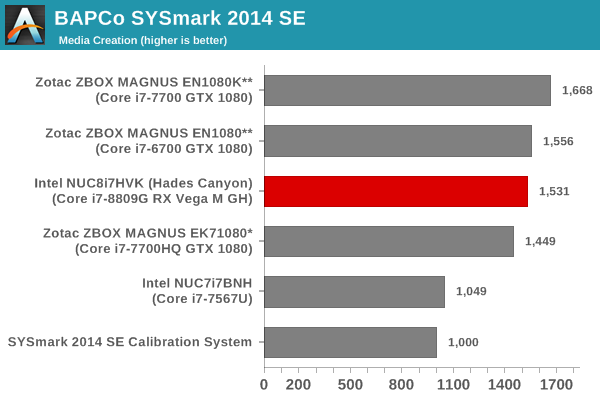

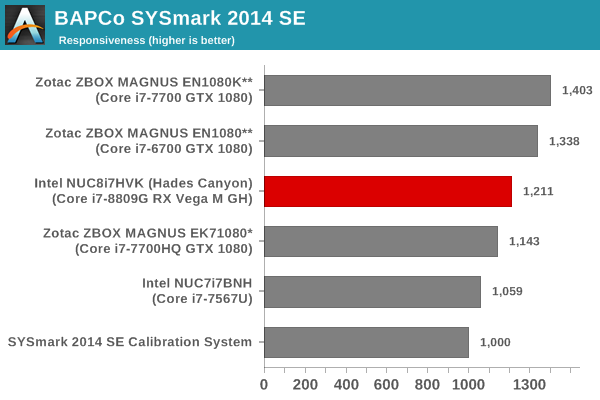
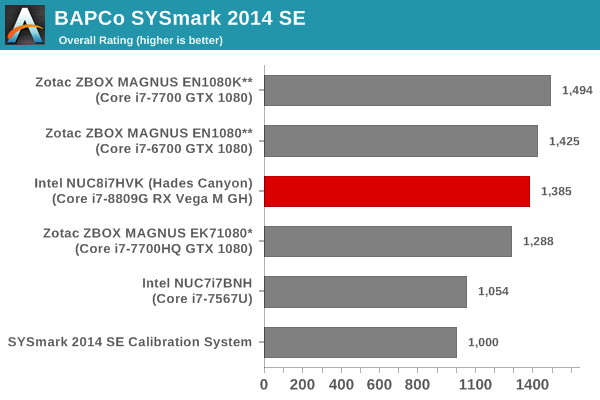
SYSmark 2014 SE also adds energy measurement to the mix. A high score in the SYSmark benchmarks might be nice to have, but, potential customers also need to determine the balance between power consumption and the efficiency of the system. For example, in the average office scenario, it might not be worth purchasing a noisy and power-hungry PC just because it ends up with a 2000 score in the SYSmark 2014 SE benchmarks. In order to provide a balanced perspective, SYSmark 2014 SE also allows vendors and decision makers to track the energy consumption during each workload. In the graphs below, we find the total energy consumed by the PC under test for a single iteration of each SYSmark 2014 SE workload and how it compares against the calibration systems.
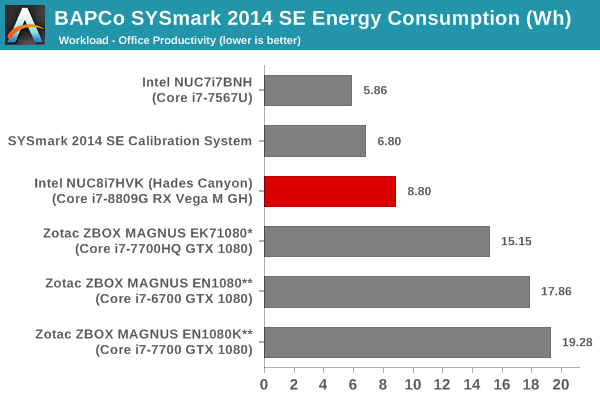
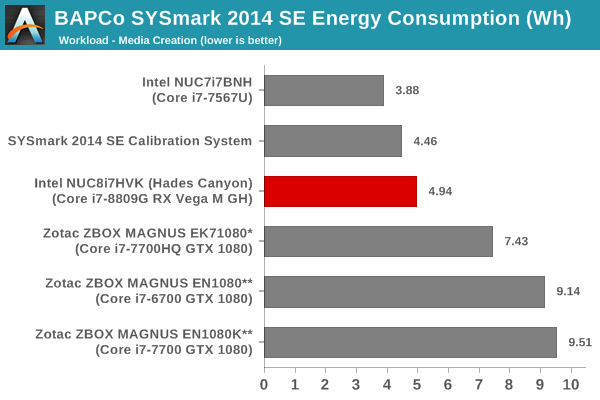
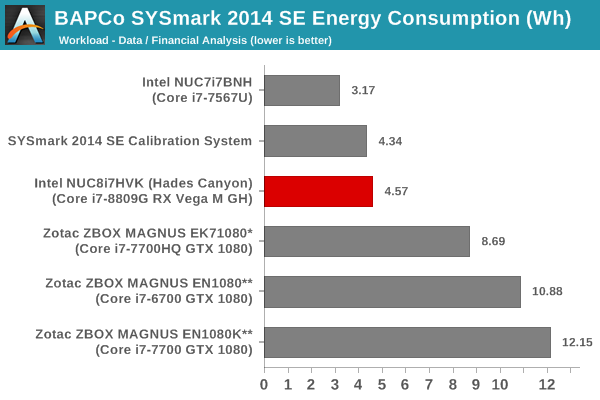

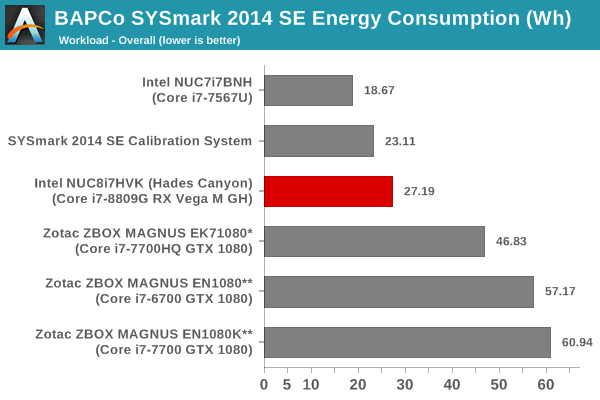
Despite being fully patched for Meltdown and Spectre, the Core i7-8809G manages to outscore the partially patched Core i7-7700HQ-based ZBOX MAGNUS EK71080. It is beat in terms of raw score by the ZBOX MAGNUS PCs using the desktop CPUs (Core i7-6700 and Core i7-7700), but, those PCs consume much more energy to complete the workloads.
Futuremark PCMark 10
UL's PCMark 10 evaluates computing systems for various usage scenarios (generic / essential tasks such as web browsing and starting up applications, productivity tasks such as editing spreadsheets and documents, gaming, and digital content creation). We benchmarked select PCs with the PCMark 10 Extended profile and recorded the scores for various scenarios. These scores are heavily influenced by the CPU and GPU in the system, though the RAM and storage device also play a part. The power plan was set to Balanced for all the PCs while processing the PCMark 10 benchmark.





Futuremark PCMark 8
We continue to present PCMark 8 benchmark results (as those have more comparison points) while our PCMark 10 scores database for systems grows in size. PCMark 8 provides various usage scenarios (home, creative and work) and offers ways to benchmark both baseline (CPU-only) as well as OpenCL accelerated (CPU + GPU) performance. We benchmarked select PCs for the OpenCL accelerated performance in all three usage scenarios. These scores are heavily influenced by the CPU in the system. The results should be analyzed while keeping in mind that most of the comparison systems have scores from the days prior to the release of the Meltdown and Spectre patches.



Miscellaneous Futuremark Benchmarks





3D Rendering - CINEBENCH R15
We have moved on from R11.5 to R15 for 3D rendering evaluation. CINEBENCH R15 provides three benchmark modes - OpenGL, single threaded and multi-threaded. Evaluation of select PCs in all three modes provided us the following results. Here, we see the benefits of running the CPU die with a 65W TDP. The scores match or beat the results from the Core i7-7700 in the ZBOX MAGNUS EN1080K.













124 Comments
View All Comments
cacnoff - Thursday, March 29, 2018 - link
I see that it can play back netflix 4k HDR?Does this make Intel the first Radeon GPU implementation to handle Playready 3.0?
patrickjp93 - Friday, March 30, 2018 - link
Actually that's handled by the iGPU on Kaby Lake. Vega is not PlayReady 3.0-capable.ganeshts - Friday, March 30, 2018 - link
On traditional KBL systems, you are right about iGPU handling PlayReady 3.0 video decoding.On the Hades Canyon, it appears that the Vega GPU is handling it. I have updated the '4K HTPC Credentials' section with the appropriate text after capturing the screenshot below:
https://images.anandtech.com/doci/12572/Netflix-GP...
gigahertz20 - Thursday, March 29, 2018 - link
I've built two Intel NUC's for family members in the past couple of years and they love them. Fast, quiet and so far reliable. They don't game at all which is why I convinced them to buy them. I'm not sure if this NUC is going to be popular at all though at $1,000 barebones. Who is going to buy it? The gaming performance of this NUC is nothing special, gamers and enthusiasts are going to stick with desktops, alot of people are just waiting for the cryptocurrency craze to die down so we can get video cards at decent prices again. If that takes another year or 2 so be it.Your average person that just needs an office computer won't buy this at $1k, you can get a much cheaper NUC and throw in a SSD and that will work fine. Why pay a premium for a cute little powerful box, if you want small and portable you can get a laptop for cheaper. If they would have priced this at $600 barebones it would have been much more appealing to your average user that might want to play the occasional game at 1080P.
Crazyeyeskillah - Thursday, March 29, 2018 - link
Nuc's have always been geared as thing clients for businesses. It's a niche market that pretty much just wants reliability and 'good enough' performance. I don't see many people loading up on the $1700 version like we see here, but Intel will get good sales from the lowest tier when ordered by the hundreds for large companies.Sailor23M - Friday, March 30, 2018 - link
I bought the Skull Canyon version last year at a good discount on newegg. I am very happy with it and intel’s support (for at least the skull canyon) has been great with a dedicated website and easy to find updates, firmware and drivers. I have it mounted behind my monitor and use it as my main PC. I’m sure that although the retail price on these is $999, you will be able to find it for much less in a few months time.The_Assimilator - Thursday, March 29, 2018 - link
For the love of god Ganesh, please, PLEASE give us proper teardowns of the units you review. That means taking the damh things apart and showing us what all the bits look like, NOT just removing the lid that allows you to access the user-upgradable bits.Crazyeyeskillah - Thursday, March 29, 2018 - link
Why do you need a tear down of this product?The_Assimilator - Monday, April 2, 2018 - link
I don't "need" it, but a review should attempt to be as thorough as possible, and for hardware that means showing as much of the system as possible.cfenton - Thursday, March 29, 2018 - link
Usually review units are on loan from the manufacturer. They aren't typically too keen on reviewers tearing them apart before returning them.